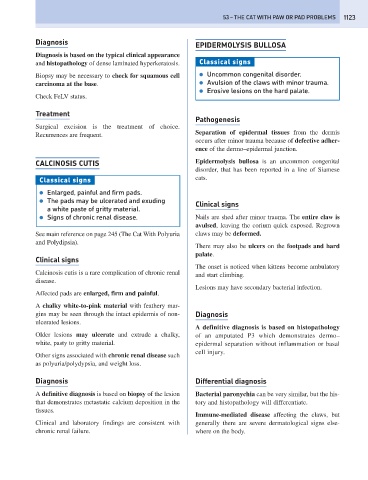Page 1131 - Problem-Based Feline Medicine
P. 1131
53 – THE CAT WITH PAW OR PAD PROBLEMS 1123
Diagnosis EPIDERMOLYSIS BULLOSA
Diagnosis is based on the typical clinical appearance
and histopathology of dense laminated hyperkeratosis. Classical signs
Biopsy may be necessary to check for squamous cell ● Uncommon congenital disorder.
carcinoma at the base. ● Avulsion of the claws with minor trauma.
● Erosive lesions on the hard palate.
Check FeLV status.
Treatment
Pathogenesis
Surgical excision is the treatment of choice.
Recurrences are frequent. Separation of epidermal tissues from the dermis
occurs after minor trauma because of defective adher-
ence of the dermo–epidermal junction.
CALCINOSIS CUTIS Epidermolysis bullosa is an uncommon congenital
disorder, that has been reported in a line of Siamese
Classical signs cats.
● Enlarged, painful and firm pads.
● The pads may be ulcerated and exuding
Clinical signs
a white paste of gritty material.
● Signs of chronic renal disease. Nails are shed after minor trauma. The entire claw is
avulsed, leaving the corium quick exposed. Regrown
See main reference on page 245 (The Cat With Polyuria claws may be deformed.
and Polydipsia).
There may also be ulcers on the footpads and hard
palate.
Clinical signs
The onset is noticed when kittens become ambulatory
Calcinosis cutis is a rare complication of chronic renal and start climbing.
disease.
Lesions may have secondary bacterial infection.
Affected pads are enlarged, firm and painful.
A chalky white-to-pink material with feathery mar-
gins may be seen through the intact epidermis of non- Diagnosis
ulcerated lesions.
A definitive diagnosis is based on histopathology
Older lesions may ulcerate and extrude a chalky, of an amputated P3 which demonstrates dermo–
white, pasty to gritty material. epidermal separation without inflammation or basal
cell injury.
Other signs associated with chronic renal disease such
as polyuria/polydypsia, and weight loss.
Diagnosis Differential diagnosis
A definitive diagnosis is based on biopsy of the lesion Bacterial paronychia can be very similar, but the his-
that demonstrates metastatic calcium deposition in the tory and histopathology will differentiate.
tissues.
Immune-mediated disease affecting the claws, but
Clinical and laboratory findings are consistent with generally there are severe dermatological signs else-
chronic renal failure. where on the body.

